Chennaiyin FC had a rollercoaster season in the 2019/20 Indian Super League campaign. From being dead last in the first half of the season to reaching the finals of the ISL, Chennaiyin had displayed some world-class fighting spirit for the fans to celebrate. Going on a goal drought for 769 straight minutes and a series of poor performances forced Chennaiyin to replace John Gregory with Owen Coyle halfway through the season. With the new manager came hope and the team had a monumental change in form which saw them string together a run of wins helping them reach the finals. At the core of this run was Anirudh Thapa, the team’s midfielder resembling LaLiga and Barcelona‘s legend Andrés Iniesta.
The 22-year-old is one of the key players in Coyle’s tactics and game plan. At such a young age, his decision making and his ability to read the game is fascinating and beyond his years. In this tactical analysis, we shall analyse his style of play and role in the tactics of his manager. This scout report will have several sections containing an analysis of his
- Role in Chennaiyin FC
- Defending abilities
- Passing and progression
- Attacking and creativity
- Area of concern
Anirudh Thapa’s role in Chennaiyin FC
Under Gregory, Chennaiyin used a 4-4-2 system where Thapa was comfortable in playing as a right centre midfielder. With the change of manager, who preferred a 4-2-3-1 system, Thapa was asked to play as a central defensive midfielder alongside Edwin Vanspaul. Thapa, who does not possess a great defending ability, still performed quite well as a defensive midfielder.
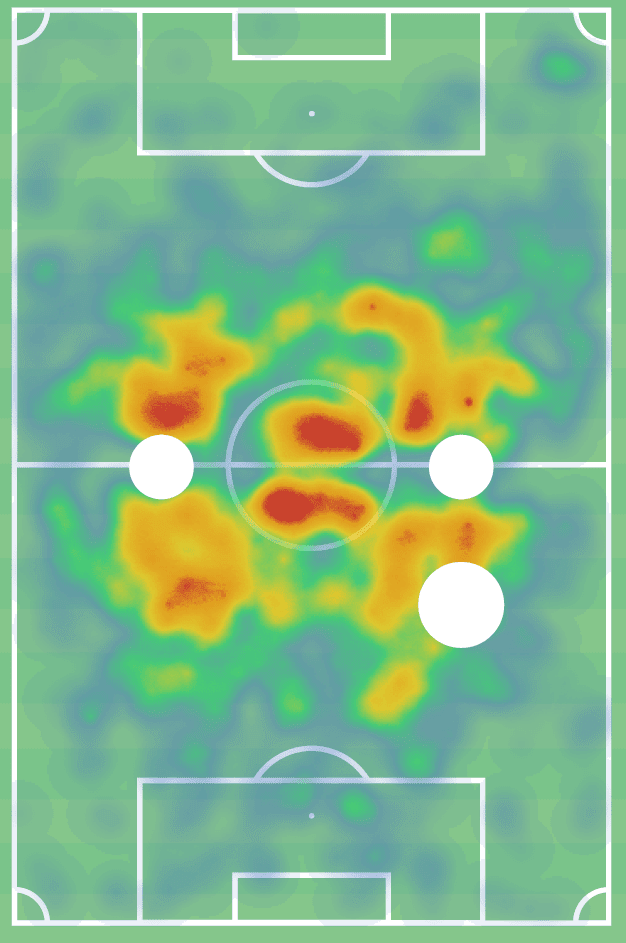
His tendency to scan the field and exploit gaps has been his standout ability throughout this campaign. His versatile positioning and intelligent runs in compact areas have been the team’s remedy to escape the opponent’s press. His eye for his teammates has helped him make those quick decisions to pass. Possessing a strong ability to change sides quickly, Thapa has helped Chennaiyin create those spaces between defenders with the help of his quick passes. His unexpected long balls helped his wing-backs combine with the team’s attack to exploit the opponents’ defence.
Being a box to box midfielder Thapa isn’t a big fan of entering the opponent’s penalty area to score goals. Rather he waits outside and helps the team finish the job. This is further explainable from the heatmap which shows how he is concentrated towards the centre of the pitch on both sides. He has influenced the overall performance of the team by actively participating in all transitions of the game. His fast feet help him to close down his opponents quickly after losing possession. His counter-pressing in opponents half helps to slow the speed of the game. His quick recoveries boost the chances of his team in creating more opportunities to score.
Let’s analyse further about these qualities of his.
Analysis of his defending ability
Even though his physique has let him down while defending against some of the toughest opponents, his situational awareness has helped him to stop the threats created by the opposition. Playing a very critical role in the midfield Thapa presses the opponents in the mid-third and gives time for his teammates to fall back.
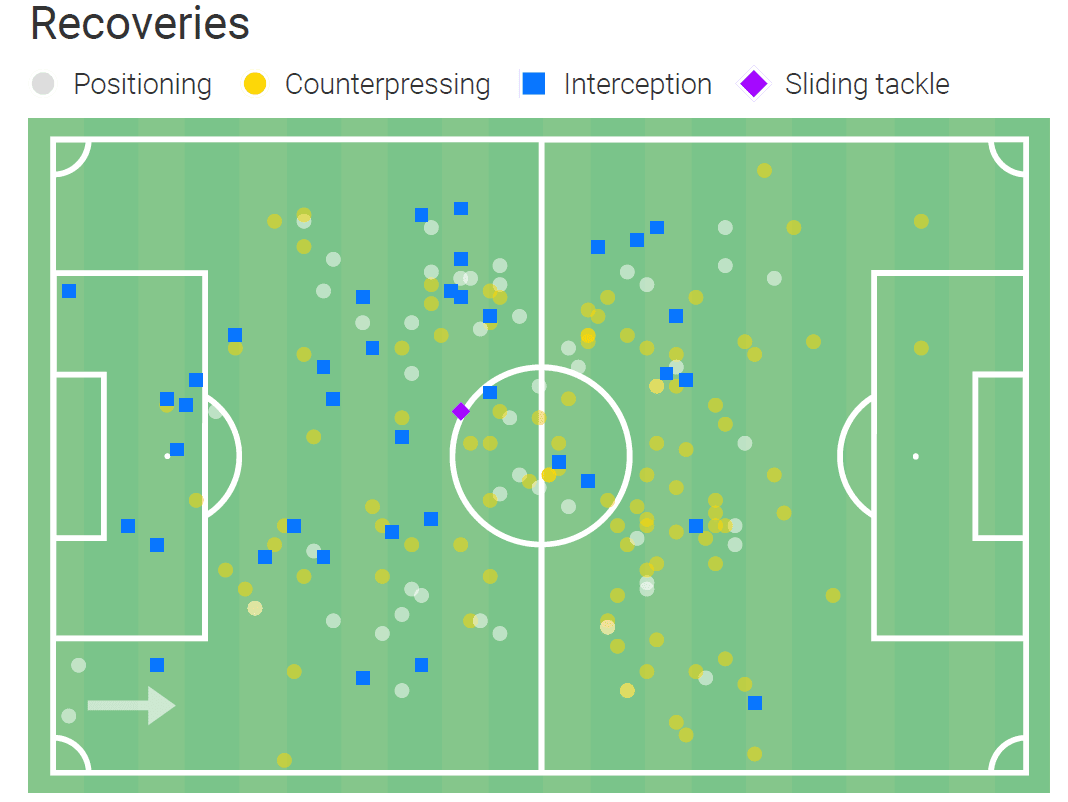
One could see most of his counter-pressing comes in the opposition half, explaining his importance in the team’s pressing and recovery. When Chennaiyin were playing in a 4-4-2 formation, the team hesitated to attack freely because of their inability to defend during counter-attacks. But when playing in the formation of 4-2-3-1, which is a lot more defensive formation than the previous formation, brought the team the balance they were looking for along with some responsibility on Thapa’s shoulders.
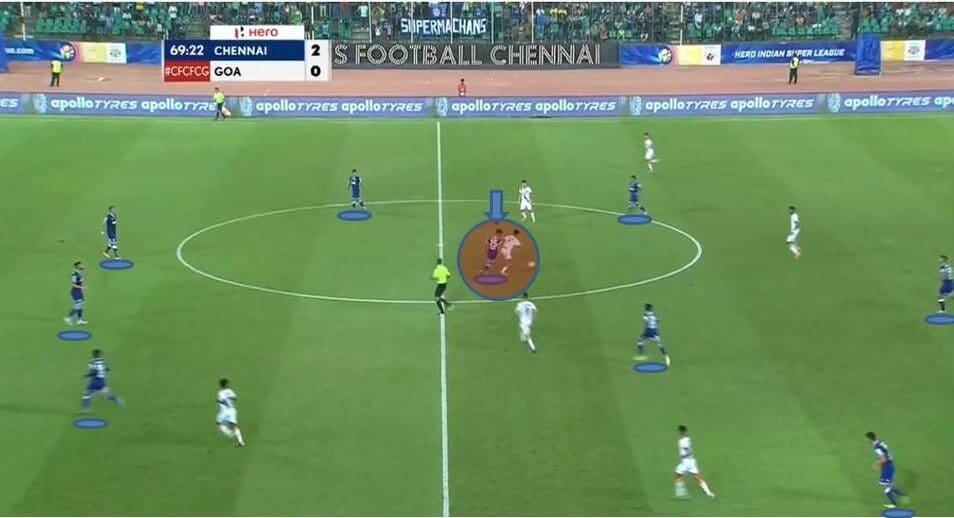
As a defensive midfielder, Thapa has to hold back in the midfield when the team is attacking and as a result, he would be the first defender to stop any counter-attack. Wise enough not to rush for tackles, Thapa intelligently presses the opponents slowing down the game as seen in the above picture. This helps Chennaiyin in falling back to their position during this transition of the game.
Handling the pressure very well, Thapa not only holds himself during the team’s attack but also combines with them quite often. When this happens Edwin stays behind as a cover while Thapa combines with the attack. Even then Thapa doesn’t forget his defensive role in the team. Staying at the edge of the opponent’s penalty box he rushes to recover balls when his strikers lose possession.
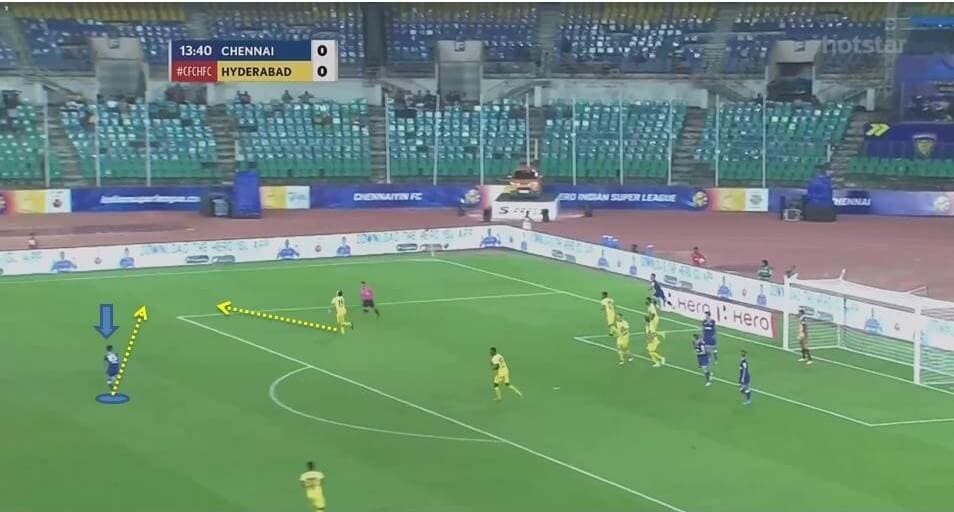
His fast feet help him to accelerate quickly and close down his opposition and recover the ball just like in the above picture. On successful pressure, Thapa now gives his team another chance to score a goal. This role has been one of the key roles under Coyle’s tactics as this helps the team to have more possession with the ball. If the ball escapes Thapa’s defensive wall in the attacking third, Thapa is quick to sprint back and support his team. His spatial awareness helps him to cut down those passing lanes making it hard for the opponents to find players in their attacking third.
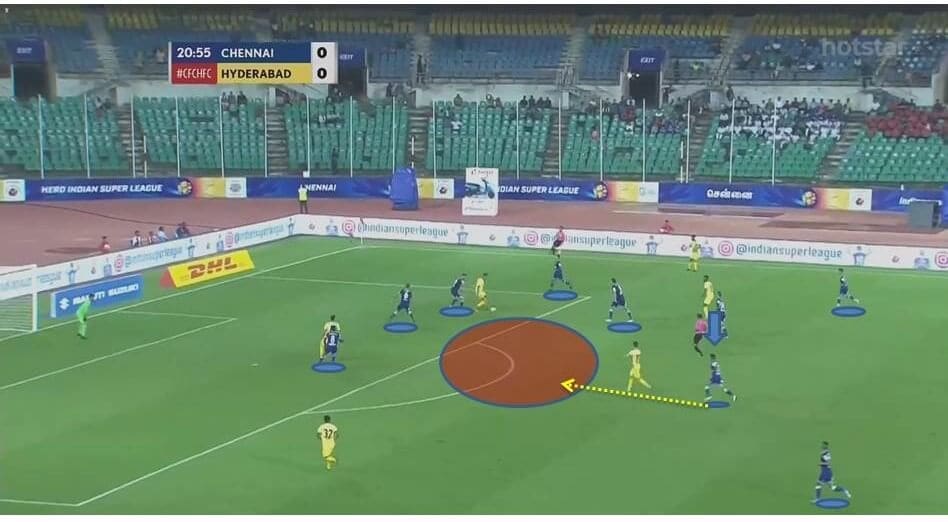
Reading the game very well, Thapa is able to sense the danger in front of him and accelerates to fill in the gap. His presence in the defensive third has helped the team fill in those unnoticed holes that they have created. Cutting down the passing lane, Thapa also makes those important interceptions to prevent the through balls. Looking at his recoveries in the first image one could see quite a number of his interceptions are in the defending third and more importantly inside the penalty area.
As said earlier he influences the team’s performance by actively participating in every transition of the game. He helps the team both in attacking and defending phases making him the most important player on the pitch.
Thapa’s passing and progression
Thapa’s speciality is his passing and progression. Mastering the basics of football, along with his vision of the field, acts as a perfect combination for the team to progress. He’s able to find those gaps very easily when compared to others in the competition. Having an attacking mind by nature, Thapa is one of those midfielders with more number of forward passes in the tournament.
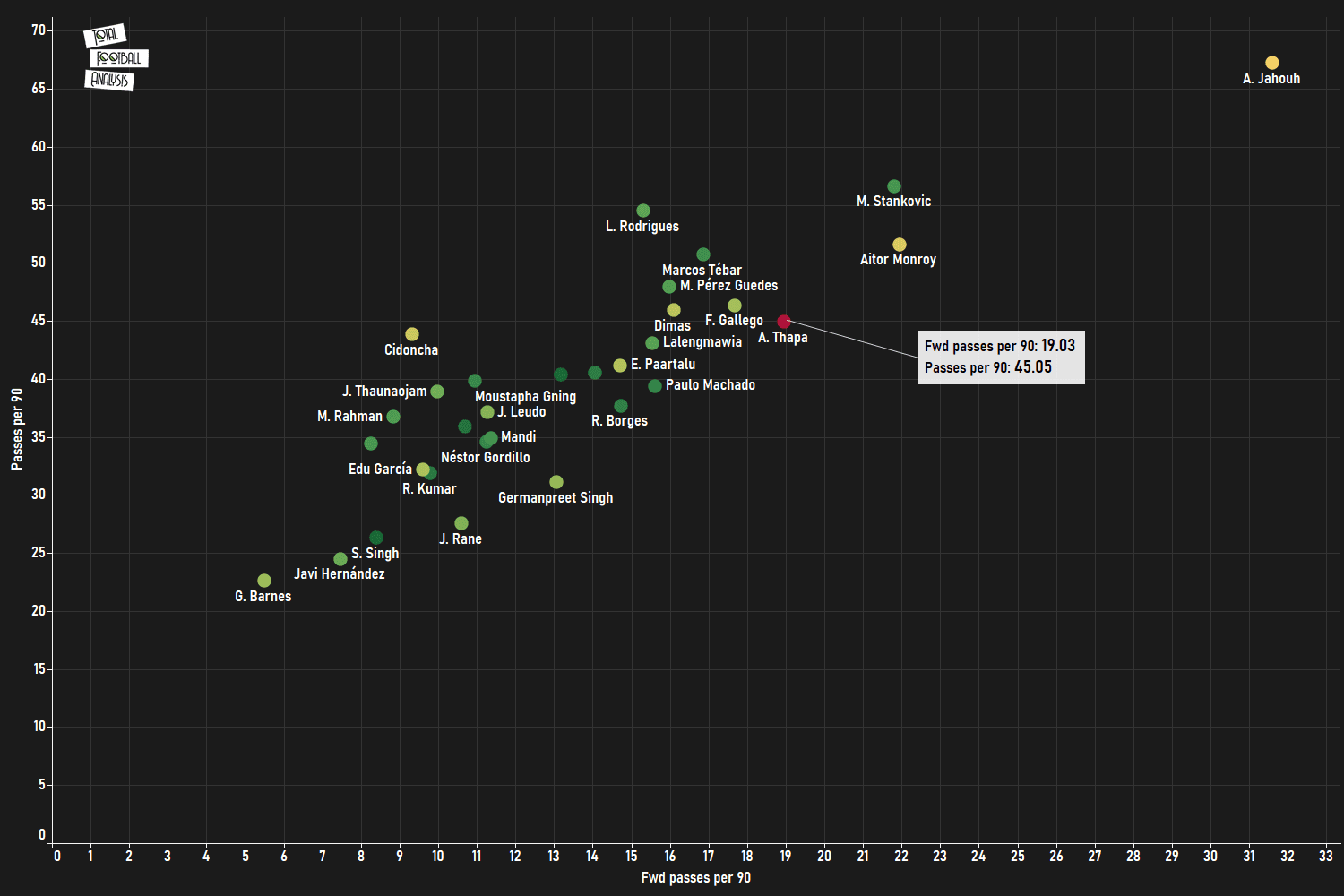
From the above graph, one sees that Thapa is the midfielder with the fourth-highest number of forward passes and first Indian with the highest number of forward passes in the competition. 19.03 of his passes are forward passes out of his 45.05 passes that he makes in a match. He does justice to his role of acting as a connecting bridge between the team’s attack and defence and also establishes his attacking nature while in a defensive role.
With a pass accuracy of 84.11%, Thapa proves to be a very good distributor of the ball. The fearless youth isn’t really scared of losing possession as he believes his team is capable of making quick recoveries. This attitude of his boosts up his confidence to make a lot of forward passes out of which a few turn out to be the game-changing pass of the match.
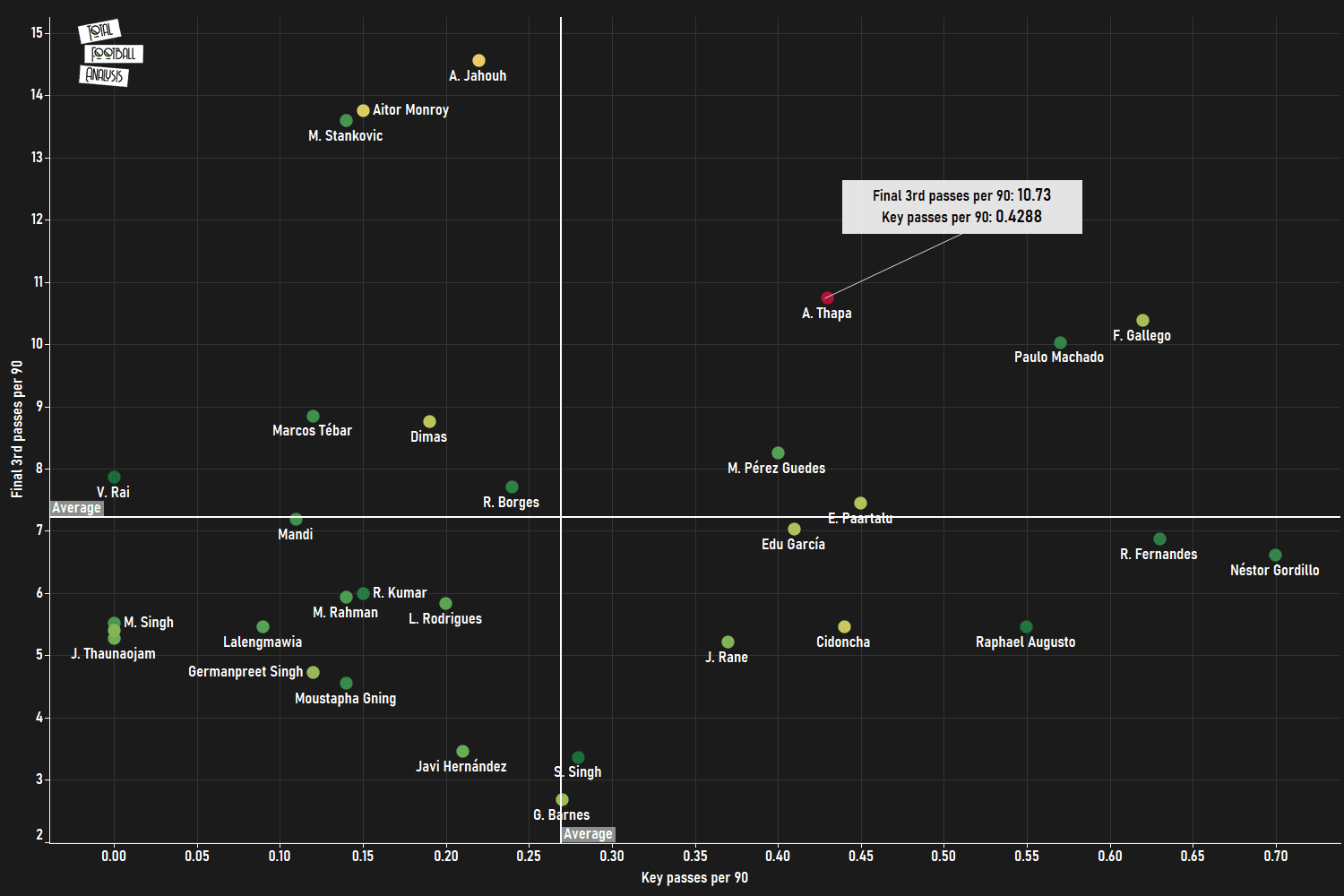
From the above graph, the right top corner box is for the players of elite-quality in making final third passes and key passes per 90 of which only five midfielders in the entire ISL have managed to occupy. By making 10.73 forward passes in a match, Thapa stands above average by quite a margin in the key passes he produces.
His ability to recognise his next pass has been exceptional which comes often in the form of a long pass. He excels in shifting sides quickly and in ease which forces the opponents to all keep shifting from side to side. This continuous shifting of sides in the centre opens gaps in the opponent’s defence and his sudden long balls are the least expected by the opponents.
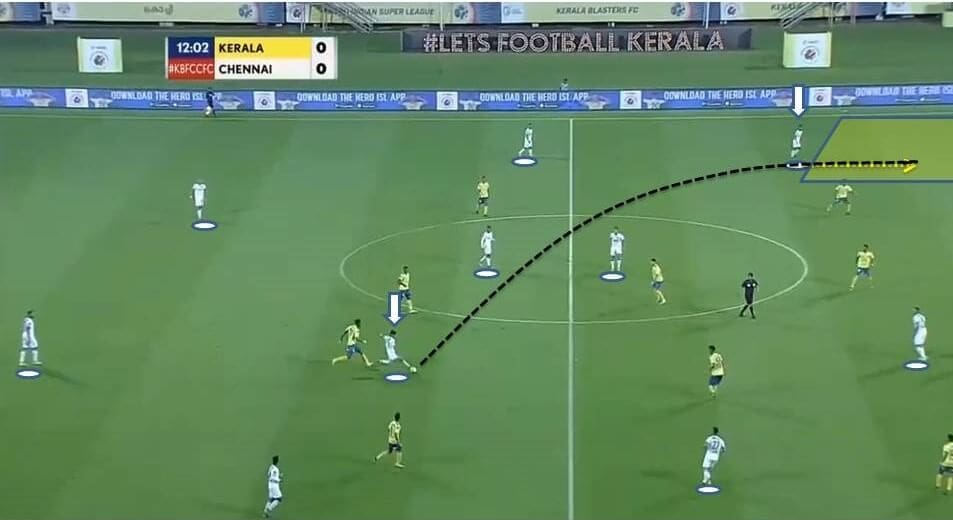
Wisely shifting the opponent’s defence on to one side and making those diagonal long passes behind the full-back has been his lethal weapon. One can see in the above picture that Thapa is playing a long pass to exploit the space behind. Lallianzuala Chhangte, one of the fastest midfielders in the side receives the ball on the run and causes additional danger.
Thapa’s role in the team’s progression does not only end with the passes he makes but also by his intelligent runs to spoil opponents’ press.
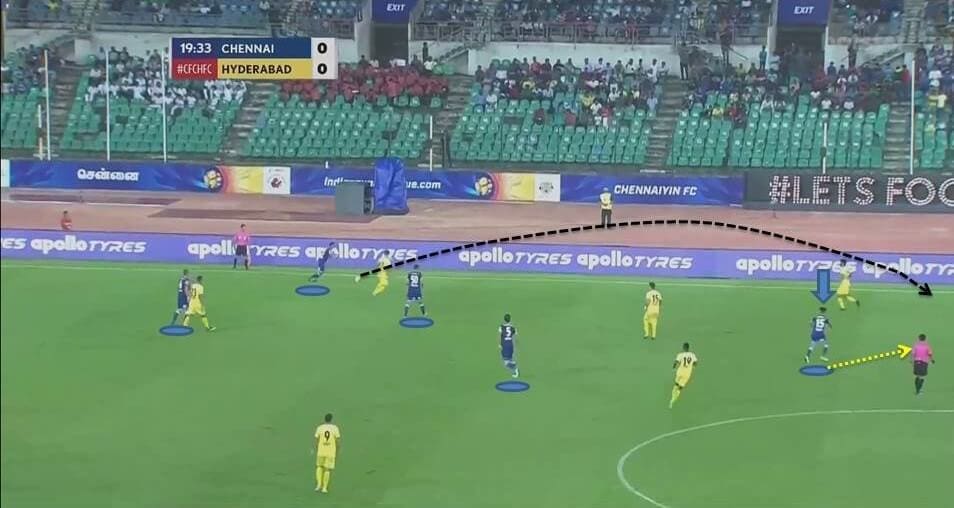
Realising that the opponents have blocked all the possible passing lanes, Thapa quickly creates space for the teammates to pass. This intelligent movement by him not only helps the team progress but also outnumbers the opponents with one quick pass. His forward runs are often dangerous because of his ability to convert these passes into key passes.
Also, his runs being quick and spontaneous gives no time for his opponent to react and this lets him go unmarked and receive the ball without pressure. Acting as a magician in this phase of the game, Thapa generates the power and phase that the team requires to progress and attack.
Analysis of his attacking and creativity
After running without a major contribution to the team’s attack in the first few games of the season, Thapa’s contribution grew immensely towards the end. Securing the maximum number of assists in the tournament, Thapa outnumbered the performance of all the midfielders in the league.
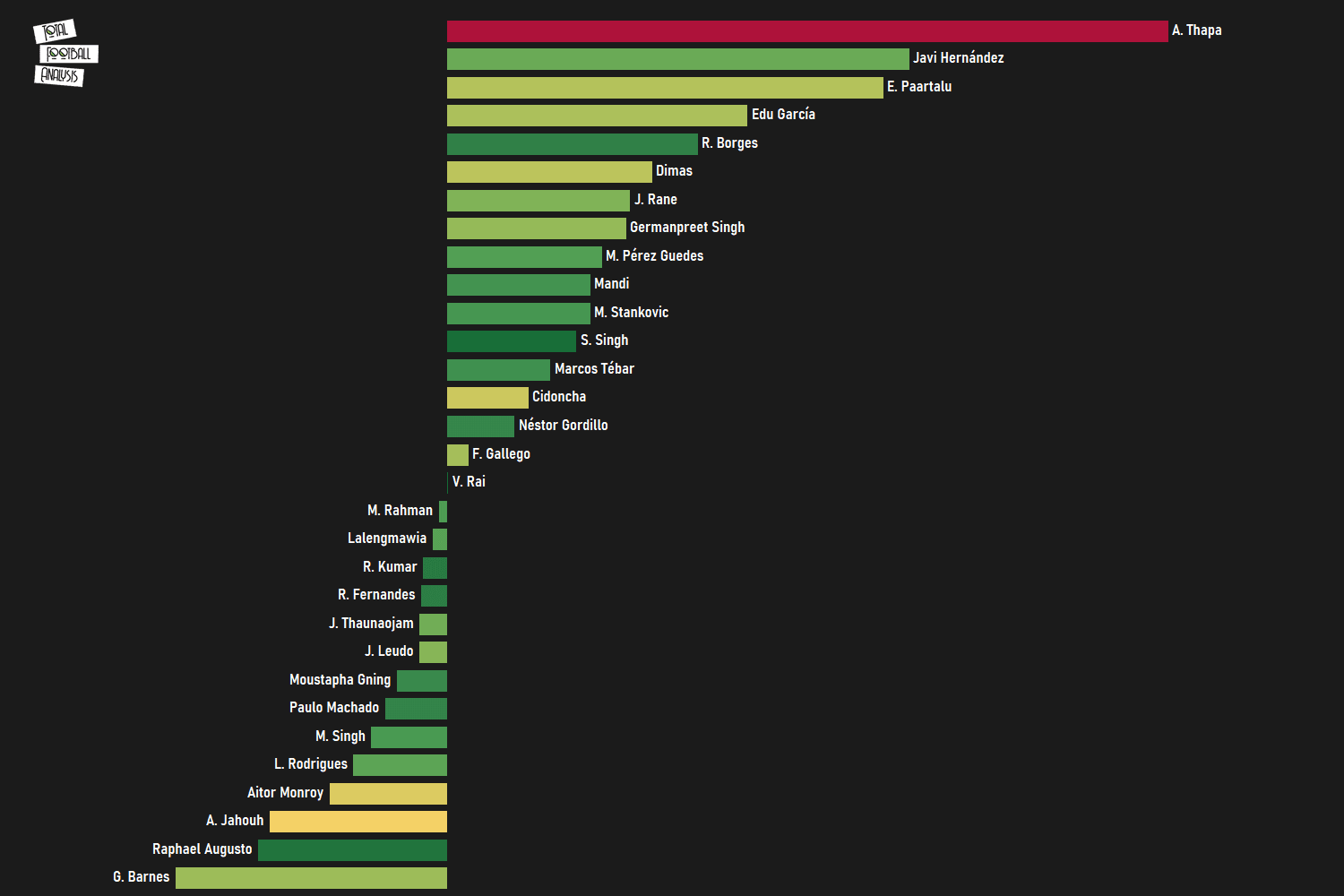
The above horizontal bar graph is a representation of the difference between a player’s actual assists and expected assists in the tournament. With few players performing below expected performance, Thapa has performed better than his expected performance by a mile. Creating chances in the final third Thapa has also helped his strikers find the net which is acceptable as Nerijus Valskis was the winner of the golden boot award this season.
The runs that the attackers make between the defence lines do not go unnoticed by Thapa. He’s quick enough to push in a through pass to support the run by their teammates.
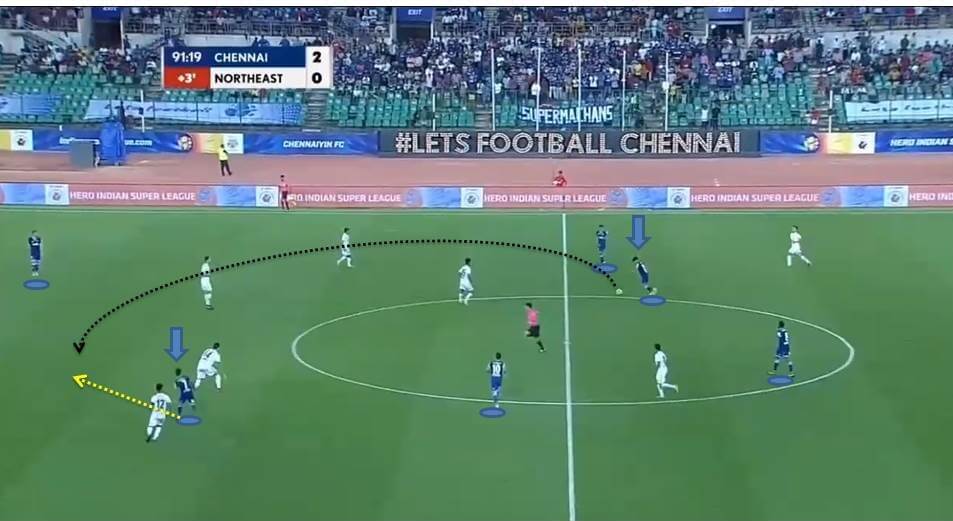
His spatial awareness helps him to spot those gaps between the defenders which help him to roll in those through passes. Although his through passes have a value of only 45% success percentage, his continuous threats in one form or the other has made it for the opponents to settle.
His actions are unpredictable which makes it impossible for the opponents to come up with a remedy to stop his influence in the game. He is also capable of making those runs into the final third carrying the ball by himself which has helped his team in opening up spaces in the final third.
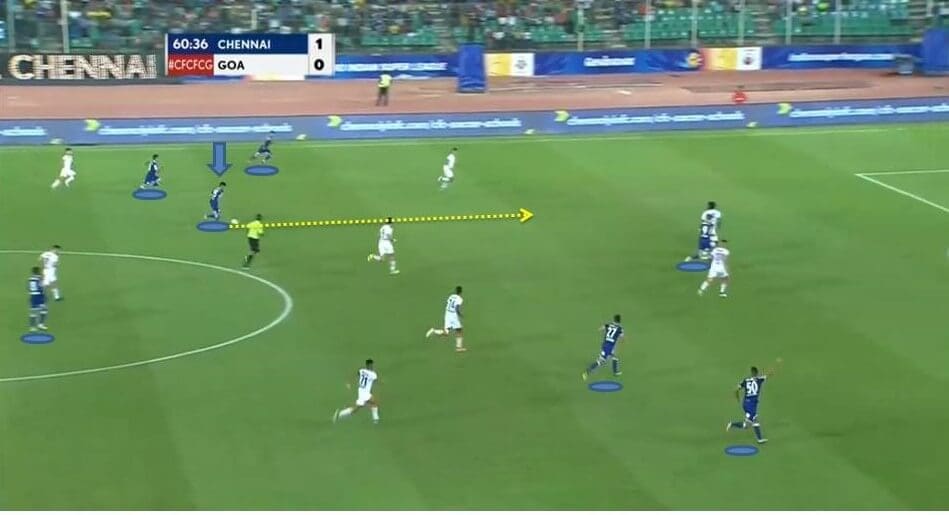
One can see from the above picture where Thapa himself carries the ball to exploit the free space in front of him. As he proceeds into the final third, the defenders would start coming at him, which as a result would free up space for either Valskis in the centre or for Chhangte who is running on the wing. Often providing the team with a numerical advantage in the final third Thapa falls back immediately when out of possession.
Thapa is one of the dangerous players when in possession in front of the penalty area. Not because of his long-range shooting ability but because of his intelligent passing into the penalty area.
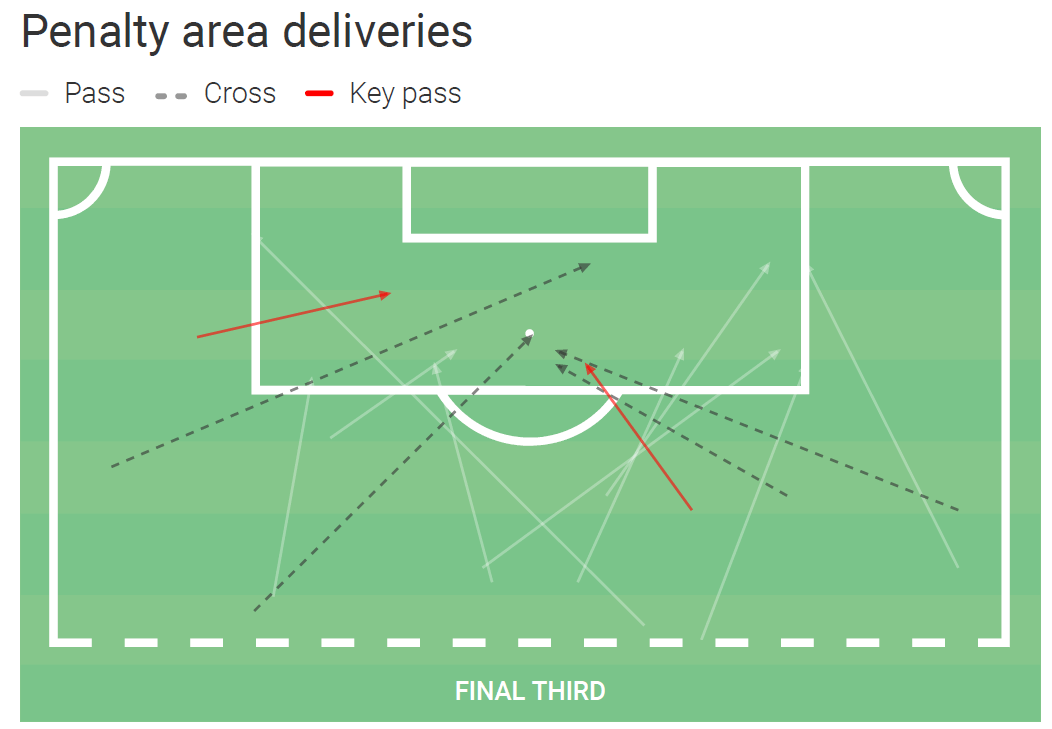
With an accuracy of 68% when it comes to passes into the penalty area, Majority of his passes are in the centre with a success percentage of 71.4%. Constantly delivering those passes and crosses into the penalty area pressurises the opponent’s goalkeeper and doesn’t let them settle. He prefers to mix up his choices of supply of balls making it completely unpredictable for the opponents to judge his actions and pass.
Acting as the key to igniting Chennaiyin’s attacking engine, Thapa’s contribution in the attacking third is irreplaceable.
Thapa’s area of concern
Although Thapa’s contribution in the team’s defending has been significant, his involvement in the defensive duels has been quite worrying. Thapa excels when it comes to positioning himself to stop those through balls and also gives his defence a perfect balance that they always want. But as an individual performer Thapa lacks in his duels.
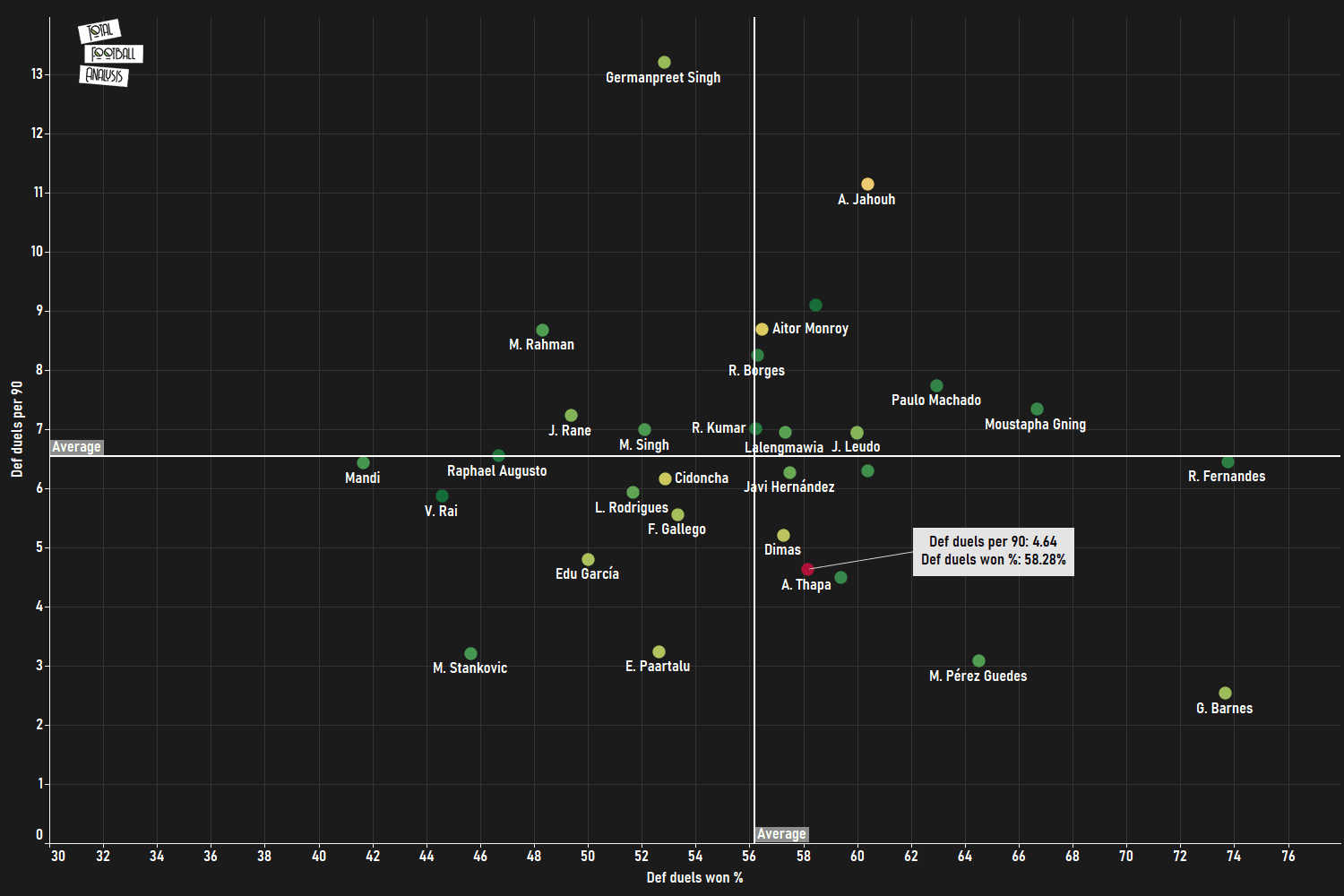
Looking at Thappa’s success in defensive duels which is pretty good (58.28%) for a player who has played more than 2000 minutes, but his involvement and participation in duels has been below average. With the kind of role he possesses in the team and the calibre he has, a lot more than just 4.44 duels per match is expected from Thapa.
This becomes a lot more worrying when we take into his aerial duels. Thapa hasn’t been a great performer in the aerial duels. This concerned area of his hasn’t been noticed as he excels in the team’s attacking and other phases, which helps him cover and compensate his lacking performance in duels.
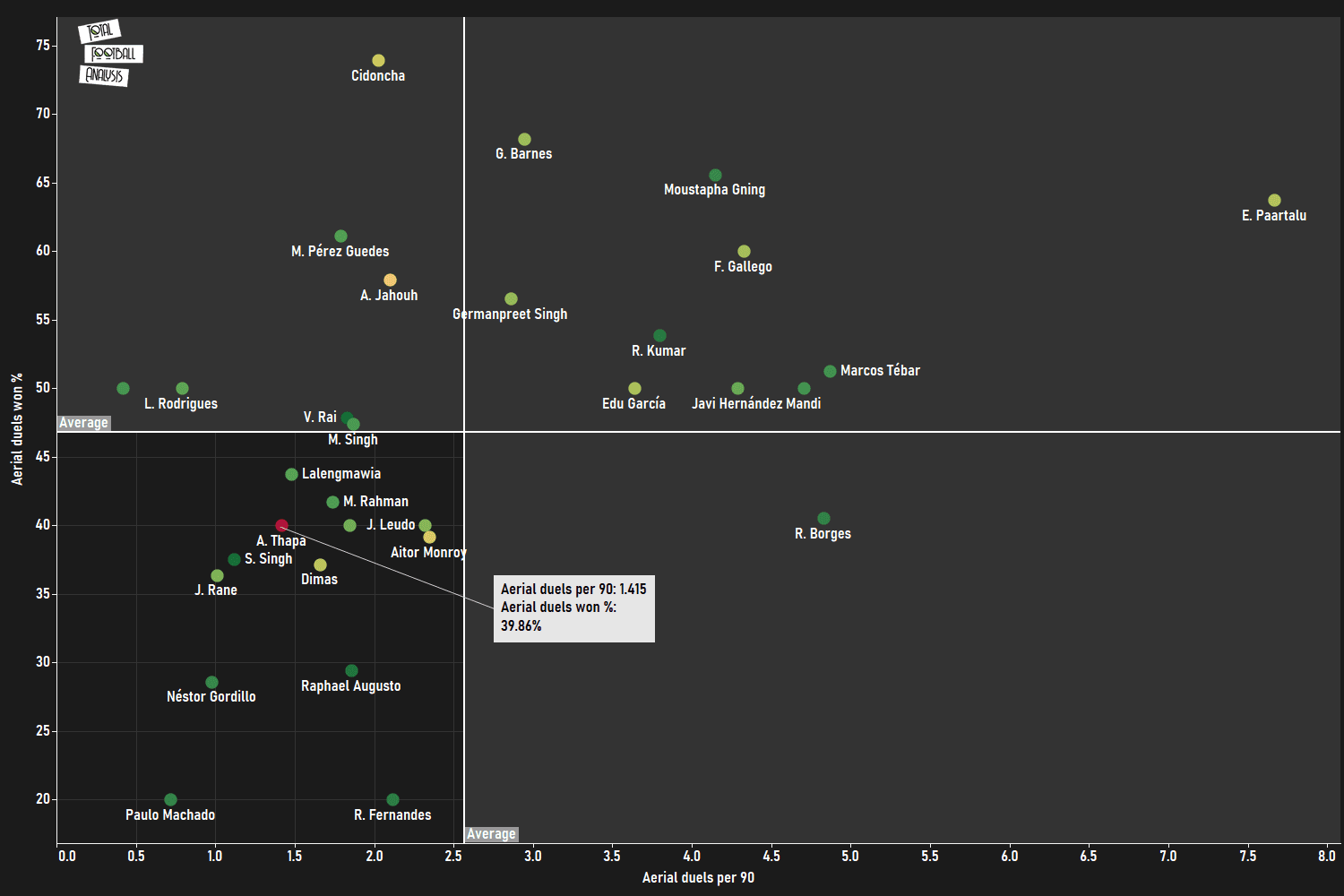
Thapa, the most reliable midfielder for Chennaiyin, is found below average in both his involvement in aerial duels and also his success percentage. It wouldn’t have been a worrying factor if Thapa was a striker, but given that he’s a central midfielder his duels play a major role in the team’s initial defending phase.
Out of his 19 losses in defensive duels, 12 of were lost in the zone 14, the area in the final third in front of the penalty area which is considered to be the most favourable area to produce danger. Out of his 12 losses in this zone, seven of them ended up being a shot in which five were on target resulting in one goal.
Conclusion
Anirudh Thapa is one of those young Indian talents who are capable of playing in Europe in the near future. But only if he works on his areas of concern and improves his duels and other qualities. At the age of 22, he possesses values beyond his level and would soon shine and catch the eyes of many clubs overseas. Extending his contract for Chennaiyin, it’ll be entertaining to see how he has improved from his previous season and how he’s going to lead the team in the upcoming campaign. As long as Thapa plays for Chennaiyin, the fans of the team would take pride in referring to him as ‘Chennaiyin’s el ilusionista’.

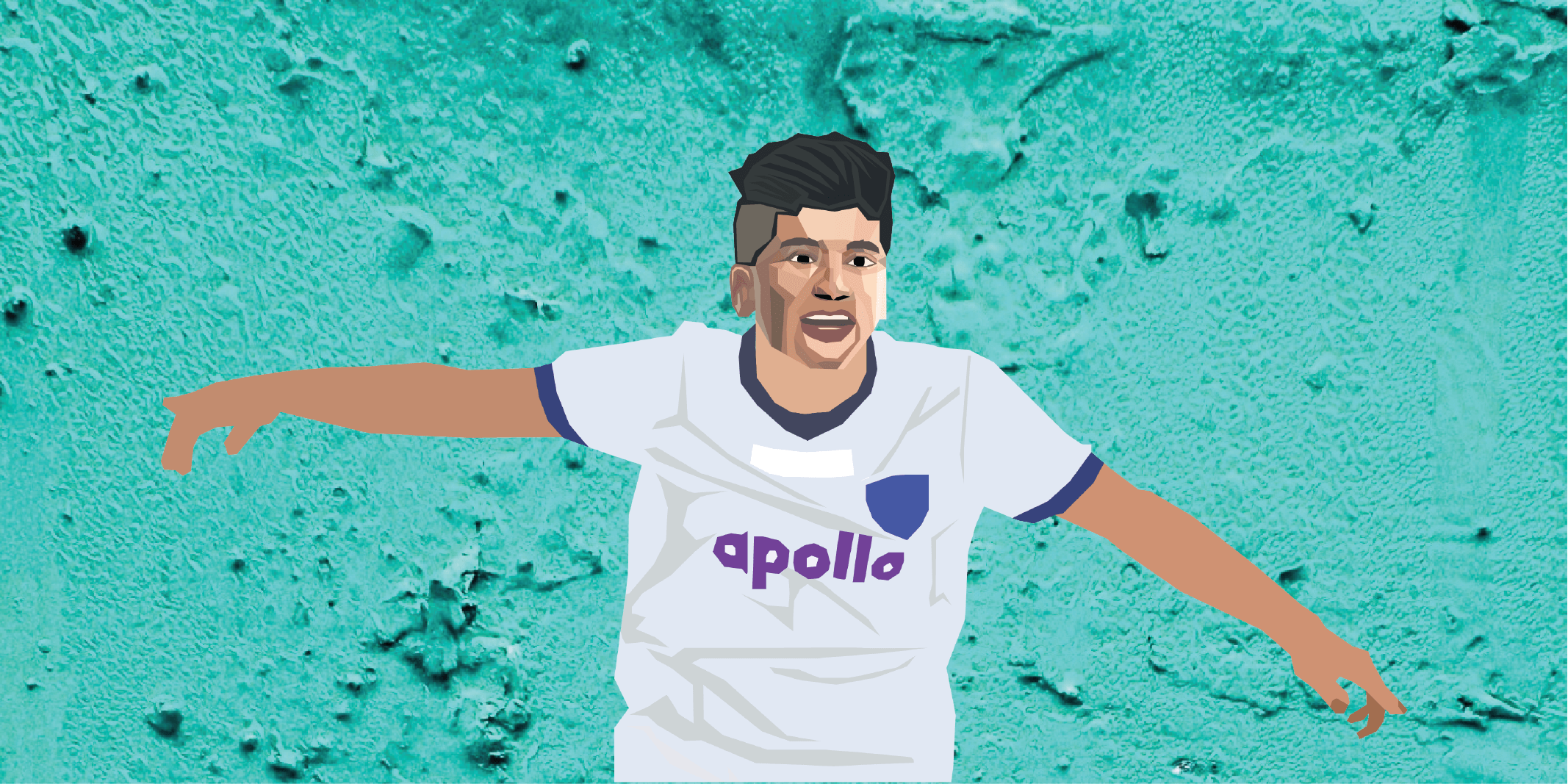



Comments